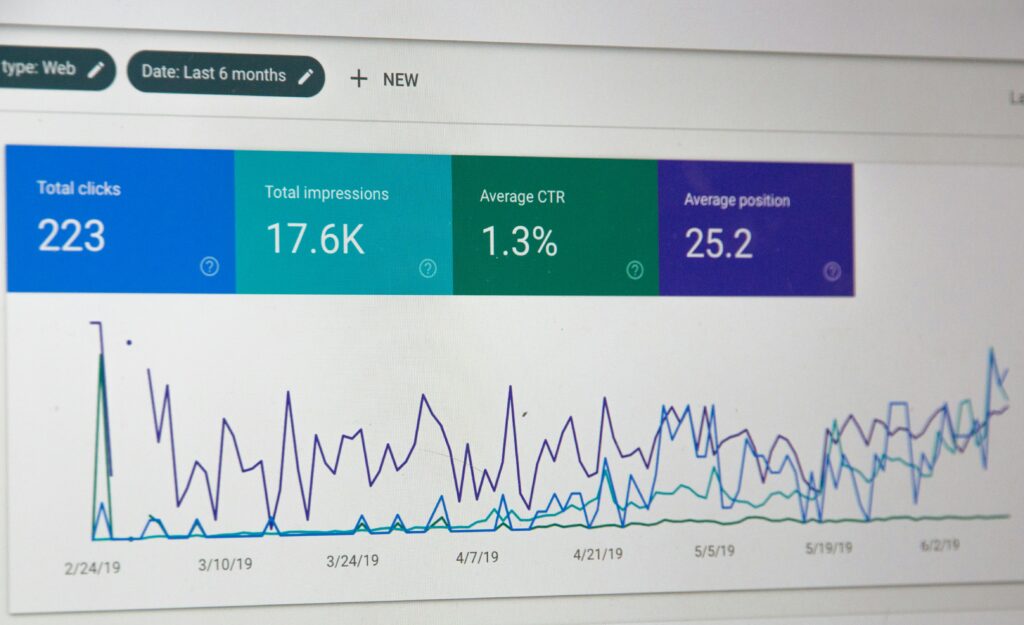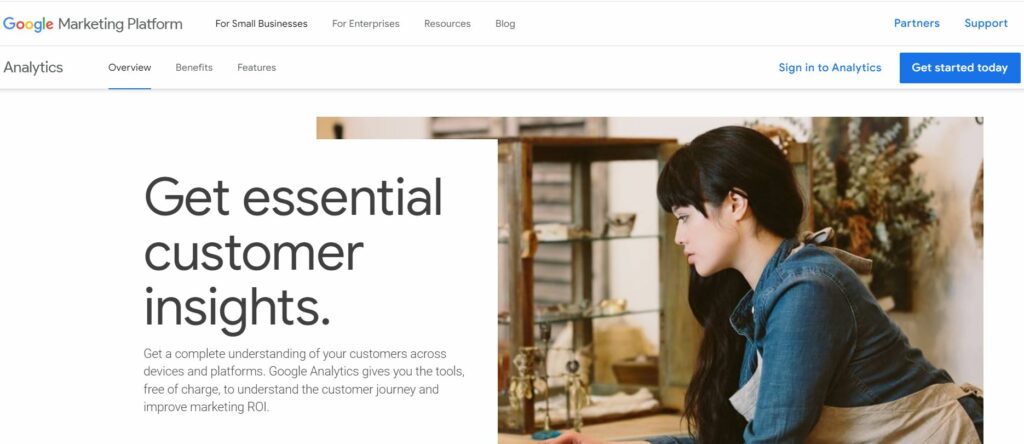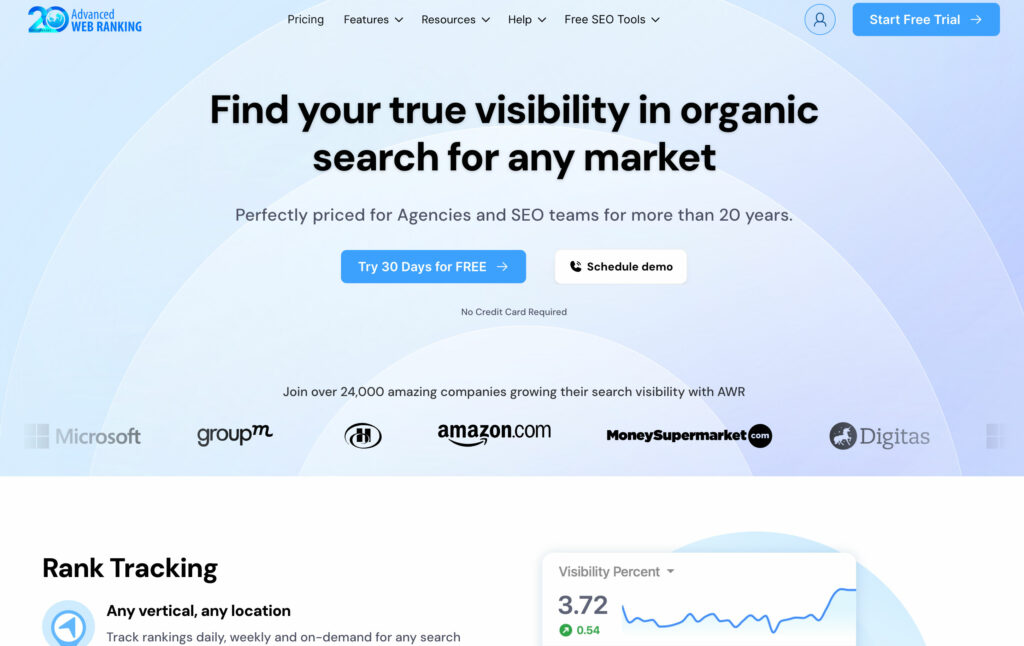Have you been negatively affected by the recent Google Core Updates? Many websites experience sudden decreases in traffic with search algorithm updates or sometimes for reasons they can’t even identify. You are not alone.
But how can you prevent this? The simple answer is through SEO forecasting.
SEO forecasting is much like trying to tell the weather. You look at certain indicators, compare as much information as you can, and try to see patterns that will indicate what will happen in the future.
Let’s go into how you can create SEO forecasts that will help you grow and maintain organic search traffic over time and stick out in a competitive landscape.
What is SEO Forecasting?
SEO forecasting is the process in which you analyze historical data, keyword search volume, market trends, and any other relevant factors that you have at your disposal to try and predict what will happen in the future.
In other words, you are trying to find potential traffic rather than take advantage of current traffic or improve current keyword rankings. By building accurate forecasts, you can take advantage of SEO traffic before your competitor activities push you to lower rankings.
Search engine algorithms are also constantly changing and adapting, so by predicting what will happen in the future, and you are able to prepare and make informed decisions that will help you maximize your online visibility and organic traffic.
For example, user experience has become increasingly important. If you picked up on the pattern early, you might have been able to make data-driven decisions and focus on improving your core web vitals, such as page loading speed.
It is important to note that, in order to maintain your rankings over time, you should focus on complex forecasts alongside your regular keyword strategy. One does not replace the other.
Make sure that you are still covering the basics of content marketing to meet your ranking goals.
Types of SEO Forecasting Models: Keyword-Level vs. Statistical
The two main types of SEO forecasting models are keyword-level models and statistical models.
Keyword-level models are rather intuitive to understand if you have been in the SEO game for a while and have some experience identifying target keywords. But if you are just starting your SEO career, it can still be a bit daunting.
If you are just starting out, check out this guide on SEO for beginners.
In short, keyword-level forecasting is where you try to predict how certain keywords will perform to find target keywords in advance. These can be single words or long-tail keywords. There is still a heavy focus placed on keyword search volume.
The idea is that you form a content creation strategy by predicting future traffic patterns and keyword performance. You could take advantage of content gaps before others identify them, drawing additional traffic to your site when.
Alternatively, statistical forecasting involves far broader trends and market dynamics. It is impossible to predict these search trends without the use of mathematical models and tools like Google Trends that provide valuable insights.
Why SEO Forecasting is Important

The online world is incredibly competitive. Everyone is constantly trying to get some sort of edge over one another to rank higher in search engine results pages (SERPs.)
This means that regular optimization techniques may no longer cut it.
By forecasting future trends in SEO and anticipating the changes that are going to occur, you can stay ahead of your competition by making data-driven decisions.
You can also work efficiently. There is no point in allocating resources to SEO efforts that are going to be outdated or even affect your traffic levels negatively with the next algorithm update.
Advantages of Implementing SEO Forecasting
SEO forecasting has many different benefits. Many of them I have already touched on above, but in short, the main ones are:
- Strategic planning.
- Resource allocation.
- Competitive advantage.
- Performance optimization.
To maximize your return on investment (ROI), ensure that your business is successful in the future and that you stay ahead of your competition and improve your SERP ranking, SEO forecasting is a very useful technique.
Your investment in SEO and in the process of accurate SEO forecasting is likely to improve your ranking position, help you attract your target audience, and give you a competitive edge that will increase your average revenue.
For more information on the cost of SEO, you can explore this article.
Key Metrics and Insights Gained
Let’s look at some of the key metrics that you might gain from trying SEO forecasting and how you can use those metrics to your advantage to improve your search rankings.
Starting with the most simple, keyword-level models will provide you with keyword performance trends. This will allow you to identify which keywords drive the most organic traffic and conversions.
Competitor analysis can also be a useful metric. If you can predict your competitor’s future actions, you can identify industry trends and areas of opportunity and stay one step ahead when it comes to SEO performance.
Seasonal trends are a great metric, although they might not necessarily apply to you if you don’t need to market a product using social media or paid search efforts, like Google Ads.
By using statistical models to map previous years, you can figure out how seasonal fluctuations might affect your prospective clients.
This, in my opinion, is particularly crucial if you are trying to sell a product or service. Consumer spending and industry trends can be greatly affected by seasonal trends like holidays.
Lastly, you will gain insight into algorithm updates. By understanding the purpose of search engine algorithms and how they have changed in the past, you can optimize for future changes.
First-Party vs. Third-Party Data in SEO Forecasting

When you are gathering the data that you will need for forecasting SEO, you can either source first-party data or third-party data.
First-party data is the kind you can collect yourself. Usually, this includes information from your own website that you can map out using tools like Google Analytics or its many alternatives.
Third-party data is from external sources, like your competitors or industry reports from analytics platforms like Google Trends.
There are also many different tools that you can use for competitor analysis. These include tools like Ubbersuggest, TruRanker, Advanced Web Ranking, or Serpple.
First-party and third-party data can be useful to you when forecasting, but the best thing to do is use a mixture of both. The more information you have when building your SEO strategy, the better.
What are Strategies for SEO Forecasting?
An effective digital marketing strategy requires a combination of analytical techniques.
Some of the main strategies for SEO forecasting include:
- Trend Analysis: Analyzing historical data to identify patterns and trends in search engine performance, monthly search volume, keyword rankings, and user behavior.
- Predictive Modeling: Using mathematical models and algorithms to forecast future outcomes based on historical data and market trends.
- Scenario Planning: Anticipating various scenarios and their potential impact on SEO growth, allowing you to develop contingency plans and mitigate risks.
- Continuous Monitoring: Regularly monitoring key metrics and performance indicators to track the effectiveness of SEO strategies and improve potential traffic.
In order to implement any of these strategies effectively, you can use some techniques and tools.
Techniques for Predicting Future Traffic and Competitor Performance
Predicting future organic traffic to your website and determining how your competitors will perform can be done through different techniques.
You can do a time series analysis where you analyze any historical traffic data that you have access to. This can help you identify patterns and forecast traffic volumes in the future.
Market research is also a great technique that will help you identify trends early and gain insight into consumer preferences to improve your SEO performance.
Utilizing SEO Forecasting Tools
SEO specialists can help you meet your business goals by providing you with complex forecasts. However, you may not have the additional budget for these kinds of services.
There are plenty of tools that you can use to build your SEO forecasting strategy and improve your SEO performance on your own.
Competitor analysis tools can help you identify and monitor your competitor’s performance, while machine learning algorithms are great at analyzing larger datasets and identifying patterns.
Most SEO forecasting tools and platforms will do both, although you may find that some are easier for you to use. Some are also only great at analyzing specific components of SEO.
For keyword research, for example, tools like Google Keyword Planner, SEMrush, and Ahrefs can give you a lot of information. You should focus on these if your goal is keyword forecasting to increase organic traffic.
However, for website analytics, you might be better off using Google Analytics or Adobe Analytics.
Likewise, Google Search Console, Moz, and Serpstat are great tools for monitoring your overall search engine ranking, while SpyFu and SimilarWeb provide insight into competitor performance and traffic sources.
Here’s a guide on how to use Google Search Console for SEO!
Sometimes, though, tools are just great all around, and one tool can be used for more than one aspect of research and reporting. Serpstat is one such example that I have reviewed.
Although many of these tools do have some cost, the potential ROI from organic traffic growth and potential conversion rate increases may make it worthwhile.
Advanced SEO Forecasting Techniques
Now that we’ve covered the basics and traditional forecasting techniques in detail, we can look at some advanced ways to generate SEO forecasts.
Machine learning algorithms and AI-powered platforms can analyze large volumes of data and identify complex patterns, industry trends, and relationships that may not be apparent through traditional analysis methods.
If you are a large business, this can help you make more accurate predictions and optimize your SEO strategies for maximum impact.
Check out this article on AI-powered SEO for more information.
This is particularly effective if you combine it with data integration from multiple sources, such as website analytics, social media metrics, and customer relationship management (CRM) systems.
Lastly, you might benefit from Natural Language Processing (NLP) techniques. NLP techniques can analyze and interpret textual data, such as search queries, user reviews, and social media posts.
NLP techniques let you optimize your content and messaging for maximum impact on your prospective clients.
I highly recommend covering the basics first, though. These advanced SEO forecasting strategies might help your future performance slightly, but the cost-to-benefit and time-to-benefit ratios are a lot less than those of simple techniques.
How to Implement SEO Forecasting in Practice
Implementing accurate forecasting can be quite overwhelming the first time. Let’s break down the different components of SEO forecasting into steps that you can use.
- Step 1: Define your objectives and KPIs.
- Step 2: Gather data.
- Step 3: Choose your forecasting models.
- Step 4: Analyze your data
- Step 5: Validate your results and make adjustments.
Define your Objectives and KPIs

Before you can start forecasting, you first need to know what you want to improve.
You can choose any metric or key performance indicator (KPI). I recommend choosing something simple to start off with. Search rankings and monthly search volume are easy because you can easily compare your current ranking or average position to future data.
Another great option is your bounce rate or click-through rate. Although this is a little more advanced, it is still a great indicator and can give you valuable insights into user behavior.
Just keep in mind which tools you have at your disposal. If you only have Google Search Console and other free SEO tools, you may not have access to a wide range of metrics that other platforms like Advanced Web Ranking may be able to provide.
Gather Data
Once you know what you are trying to improve, you need to collect the relevant data.
You can do so by using website analytics, keyword research tools, and conducting competitor analysis, as discussed already. Remember to collect both first- and third-party data wherever possible.
It might be worthwhile comparing the data from multiple tools. If you aren’t able to do that, I would recommend choosing the best tool you can access and sticking to it to avoid confusion.
Choose your forecasting models.
When you have your data, and have converted it into a useable format, you need to decide on a forecasting model.
Trend analysis and predictive modeling are a great place to start.
Analyze your data
Finally, you need to analyze your data and form your predictions for the future. Identify potential opportunities and build your content strategies going forward.
This is not an exact science. Potential outcomes are never certain.
Some basic statistical or analytics tools like Google Analytics might help you, and some people offer an SEO forecasting template, but even third-party tools may not be able to make accurate predictions.
Validate your results and make adjustments.
Give yourself a set time period over which to test your predictions. I would recommend shorter periods of time, such as three months, and longer periods, such as 12-month intervals, to analyze the impact of SEO efforts.
Observe your search engine rankings as they change, always comparing them to your current rankings for detailed insights.
Remember your initial KPI, but also ensure that other performance indicators, such as your average conversion rate or average click-through rate, have not been affected negatively.
Is there anything that you can do to improve and refine your digital marketing strategy and search rankings further? Were there potential opportunities that you missed because of your predictions?
It is always important to scrutinize your forecasts and the impact of SEO efforts. This will help you learn and perhaps increase the accuracy of any future predictions and content strategies to meet your ranking goals.
What to Avoid in SEO Forecasting
There are a couple of things that you need to avoid when SEO forecasting in order to create accurate forecasts that ensure your success.
- Overlooking Data Quality: Ensure data accuracy and completeness by validating and cleaning your data before conducting forecasts, removing bot traffic, etc. This can be a time-consuming process, but tools like Google Sheets can make it easier.
- Neglecting External Factors: You need to consider external factors such as market trends and competitor strategies when making forecasts to avoid inaccuracies. Never rely solely on internal data to create your SEO campaign.
- Relying Solely on Historical Data: Historical performance is important, but you also need to incorporate market intelligence and real-time data into your forecasts to account for changes in consumer behavior and industry dynamics.
- Ignoring Model Validation: Validate your forecasting models against actual performance data, such as search ranking, to ensure accuracy and reliability. This is especially important if you are new to the forecasting process.
Join 900+ to receive a weekly SEO video from my YouTube channel, which I’ll share, and an actionable SEO tip every week.
Wrap-Up
An SEO forecasting strategy is a powerful tool that can help you anticipate the future.
Whether you are trying to use it to identify trends, improve your search performance, or make sure your traffic potential survives the next algorithm update, it might be worth looking into.
The potential return is great. Just remember that inaccurate forecasting may have a negative effect on your overall SEO goals, so be careful.
To keep up to date with the latest in SEO and improve your current strategy, I recommend checking out some of these podcasts. They provide valuable insights and real-time updates on this complex field.
FAQ
What is an SEO monitor?
An SEO monitor is a tool that you can use to track and analyze different metrics. Some tools let you track keyword rankings, organic traffic, backlinks, internal linking, and more. You can use this information to make informed decisions.
What is the formula for SEO forecasting?
The formula for SEO forecasting can depend on the data that you are using. You need to use statistical techniques and predictive modeling alongside data analysis methods that help you move toward certain objectives.
Why is SEO forecasting difficult?
SEO forecasting is difficult because search engine algorithms are constantly changing. SEO data also has a large amount of variability, so it can be difficult to predict the future.


